

January is less bleak with a tasty Frosty the Snowman in white chocolate, from Woodhouse Chocolate.
|
| Gourmet News is compiled by MELODY LAN. |
|
|
 |

Gourmet News & Views
January 2006
The Scoop on Super Bowl Take-Out Food. According to the National Restaurant Association, approximately 15 percent of Americans have restaurant food delivered to the home of where a Super Bowl® gathering is held. This year, Super Bowl Sunday falls on February 5th. See if your Super Bowl eating habits are similar to the results found from the research.
|

Chicken wings: "The Runner Up" of the top three
most popular Super Bowl foods. Photo by GG. |
- For young adults, between the ages 18 to 34, who watch the big game, 22 percent order takeout for Super Bowl parties.
- Of those who order takeout or delivery, 58 percent order pizza, 50 percent order chicken wings and 20 percent order sandwiches.
- Those who live in a household with more than 3 members, a city, or in the Northeast were more likely than others to order takeout or delivery for the Super Bowl.
- One in 20 Americans watch the Super Bowl at a bar or restaurant.
2006: Bountiful Tomato Harvest. According to The Washington Post, when Hurricane Wilma struck Florida last October, tomato prices at retail markets nationwide hovered in the $4 per pound range, up about $1.50. As a result, some restaurants even removed tomatoes from dishes altogether or only provided them upon special request. However, Florida farmers have rebuilt and replanted Florida’s fresh fruits and vegetables and the devastated crops have begun to be restored. Florida Agriculture Commissioner Charles H. Bronson explains that the tomato supply is back up and retail prices should fall accordingly.
|
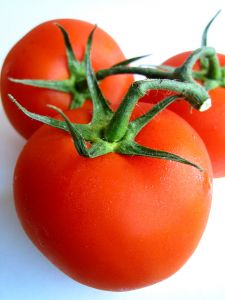
Tomatoes are one of the best sources of lycopene, a carotenoid with cancer-fighting properties. Photo by Jean Olufsen. |
New Product Watch: Guittard Chocolate. E. Guittard, an artisanal chocolate company based in Burlingame, California, recently introduced its Single Origin Chocolate Tasting Kit. The sampler contains four single origin chocolate bars, available in Ambanja, Chuchuri, Quevedo, and Sur del Lago. Also included in the kit is the Chocolate Education Booklet, which covers an overview of the company, regions of cacao plantations, bean varieties and the chocolate making process.
|
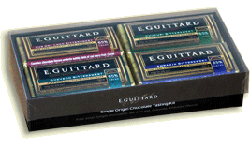 Guittard’s new Single Origin Chocolate Tasting Kit comes with four different 10 gram single origin bars and a chocolate tasting guide. Guittard’s new Single Origin Chocolate Tasting Kit comes with four different 10 gram single origin bars and a chocolate tasting guide. |
Though each bar is crafted from a different variety of cacao bean grown from a specific region, all four types each contain 65 percent cacao and 35 percent sugar. Ambanja is made from beans found in Madagascar and has a tart, fruit-like essence. While Chuchuri, with beans from Colombia, suggests hints of peppery heat, Quevedo, made from beans grown in Ecuador, has a full-forward floral flavor. Sur del Lago, made from beans from Venezuela, is touched with berry flavor. Click here to read our article on Understanding Prestige Chocolate.
1.23.06
Lunch breaks at the desk. According to the American Dietetic Association (ADA), 75 percent of office workers in America eat lunch at their desks about two or three times a week. In an article from the Washington Post, dietitian Bonnie Taub-Dix of the ADA explains that a dish with chicken and vegetables at a restaurant isn’t that much different from a healthy to-go meal with the same ingredients. What’s important is making healthy meal choices even when you have time constraints at work.
|
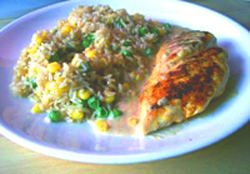
Whether you get out for a hot “nourishing” lunch or have a wrap at your desk, there isn’t much of a difference, as long as both versions have healthy ingredients. Photo courtesy of Elisa Nobe. |
Taub-Dix also states that what is at risk is enjoyment of your meal—and “desk diners” are more likely to give in to munching on junk food. If you are prone to snacking in place of meals or as a supplement, there are plenty of healthy snacks to enjoy at the office too. Click here to read our article on Healthy Office Snacks.
“New” lettuce wraps. Wrapping foods in lettuce instead of bread was big in the days of low-carb dieting. Recently-launched Lettuce Jammers is presenting itself as a “new” lettuce product—packaged, pre-washed lettuce leaves, that can be filled with chicken and broccoli, tuna salad, or anything you choose. Positioned as fancy "wrap" lettuce, does it present the consumer with anything beyond one could find in the middle of a head of romaine, Boston, or other leaf lettuces?
|
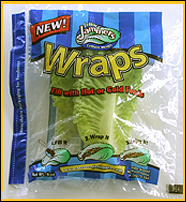 |
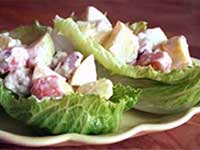 The producers state that the wrappers from Lettuce Jammers are durable enough to hold hot or cold fillings, and that the pieces come in a “boat” shape. But it only takes a few minutes to break off and rinse any lettuce leaves, which come naturally curved to cradle any filling of your choice. It may be the emperor’s new clothes, but if gets more people to substitute lettuce for bread, we’re all for it. The producers state that the wrappers from Lettuce Jammers are durable enough to hold hot or cold fillings, and that the pieces come in a “boat” shape. But it only takes a few minutes to break off and rinse any lettuce leaves, which come naturally curved to cradle any filling of your choice. It may be the emperor’s new clothes, but if gets more people to substitute lettuce for bread, we’re all for it.
New Product Watch: Pomegranate Liqueur. By Spring of 2006, PAMA™ Pomegranate Liqueur will be launched in upscale markets nationwide. Made with all-natural California pomegranates, PAMA is bottled at a mixable 34 proof (17% alcohol by volume). It is said to be both sweet and tart in taste. The liqueur will be available in 750ml with a suggested retail price of $24.99.
|
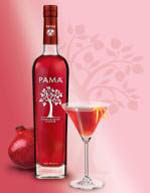
Photo courtesy of PRNewsFoto/
Heaven Hill Distilleries, Inc. |
Pomegranate was last year’s “fashion flavor,” and the demand for pomegranate-based foods and beverages is still on the rise. Innovative cocktail mixing continues to be a hot trend. The desire for novel, mixable and colorful spirits makes the release of this red liqueur opportune. If you enjoy cocktail mixing, click here to check out the Cocktails section of THE NIBBLE™.
1.16.06
Winter Fancy Food Show begins next week. Nearly 1,100 exhibitors will be displaying more than 80,000 distinctive specialty foods at the 31st Winter Fancy Food Show® in San Francisco. THE NIBBLE™ editors will of course be there, looking for “the best of the best” products for you. Fancy Food Shows, the industry’s largest specialty food events, are held three times a year: January in San Francisco, May in Chicago, and July in New York City. They are open to the trade only: retail buyers, brokers, caterers, cooking schools, distributors, food service, importers, manufacturers, and the press. The shows are presented by the National Association for the Specialty Food Trade (NASFT), the industry’s professional association. For more information, visit:
FancyFoodShows.com.
|
 |
Specialty coffee continues to rise. According to E-Imports, an espresso business solutions provider for the specialty coffee industry, specialty coffee sales have risen 20 percent each year and account for 8 percent of the billion dollar U.S. coffee industry. A study jointly conducted by The National Coffee Association and The Specialty Coffee Association of America found that more than 100 million Americans over the age of 18 drink coffee every day. See if the statistics below match up with your daily java intake:
|

35 percent of coffee drinkers take their coffee black. Photo courtesy of Brandon Keim.
|
- 30 million coffee drinkers drink specialty coffee on a daily basis, including mochas, lattes, cappuccinos, and blended coffee drinks.
- Americans consume 400 million cups of coffee per day, making the U.S. the leading consumer of coffee in the world.
- Seventy-five percent of the 400 million cups made each day is home-brewed.
- The average coffee drinker consumes 3.2 cups per day.
- Women say drinking coffee helps them relax, men say drinking coffee helps them at work efficiently.
Click here for more information about coffee in THE NIBBLE’s Coffee section.
New Product Watch: Soy Tortillas. Tumaro’s Gourmet Tortillas has launched a new line of flatbreads using solae soy protein. Soy-full Heart Flatbreads are the first nationally distributed soy fortified flatbreads in America. Each serving contains 4 grams of fiber and 6 grams of protein. They are available in Wheat, Soy & Flax, 8 Grain ’N Soy, and Apple ’N Cinnamon. All three varieties are kosher, 92 percent fat-free, low in cholesterol and sodium, and have zero grams of trans fats. Tumaro’s Gourmet Tortillas also have a healthy, low-carb multigrain tortilla, as well as other delicious tortilla flavors, including Jalapeño & Cilantro and Pineapple-Banana.
|
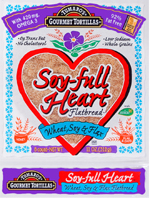
These flatbreads are approved as
a good source of whole grains by
the Whole Grains Council, as they
contain oat, wheat, red wheat, rye,
barley, buckwheat, and rice.
|
1.9.06
Kobe Beef Returns to the U.S. In 2001, the U.S. banned Japanese beef imports due to the 21 cases of mad cow disease found in Japan. But last month, the U.S. Department of Agriculture lifted the ban to allow whole cuts of boneless beef from Japan to enter the U.S. under certain conditions. This means that Japanese Kobe beef, recognized for its gorgeous marbled fat, can again be sold to American beefeaters who demand the best (like Kobe Bryant’s father, who named him after the food of which he was so enamored).
|
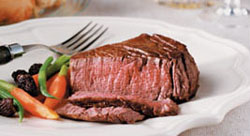
Kobe Beef...just in time for Valentine’s Day! |
Kobe’s American Cousin. Authentic Kobe beef comes from a breed of cattle called Wagyu, which come from the prefecture of Kobe, Japan. When the tradition began, it is said that the Wagyu cattle were massaged with and fed on a diet of sake, giving way to their well-marbled fat and tender meat—although today, just the legend remains (large herds can’t get such personal treatment). American consumers can also purchase American-style “Kobe beef,” which is made from crossing the Japanese Wagyu cattle, which arrived in the U.S. in the 1990s, with the American Angus breed. According to the Associated Press, real Japanese Wagyu cattle are fattened for much longer —between 26 to 32 months—than the average American breed, which is raised for about 18 months.
Stephen Smith, a Texas A&M University researcher, explains that his studies show that Wagyu beef contains more unsaturated fat than American beef. Wagyu meat has higher levels of oleic acid, which is known to lower “bad” cholesterol. But you aren’t limited to the meat produced from the Wagyu if you are looking for a healthy red meat. Click here to read our article on Organic and Natural Meat to learn about your other options.
Remembrances of Things Past #1: Shark Fin Soup. Thought to endow medicinal properties, shark fin soup was considered a delicacy in Southern China until the late 1980s. In the past 15 years, it has become a popular dish in many Asian restaurants throughout the world. Researchers and marine biologists find that the product’s demand has caused some of the shark population to decline by as much as 70 percent. According to The New York Times, some sharks like the silk tip have become extinct from the Caribbean.
|
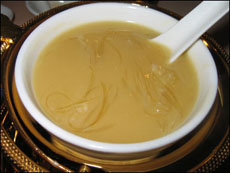
Photo courtesy of Wikipedia.org. |
Properties ascribed to the shark’s fin have deep roots in Chinese tradition. The Compendium of Materia Medica, a pharmaceutical text written by Li Shizhen during the Ming Dynasty of China, asserts that shark’s fin soup strengthens the waist, supplements energy, nourishes blood, and improves digestion. (Western medicine does not verify these claims.)
Blue, hammerhead and silky sharks are the most commonly traded in Hong Kong for shark fin soup. The United Nations Food and Agriculture Organization deduces that 856,000 tons of shark and fellow species, including rays and skates, were caught in 2003— triple the quantity of five decades earlier.
Shark fin soup can be purchased for as much as $100 per bowl in Hong Kong, and up to $200 in the U.S. But money isn’t the issue: the demand for shark fins has caused the number of sharks in the sea to decline, and at some point there may be no bowls of soup at any price. Click here to read our article on Seafood Watch to learn about the health and environmental issues related to the seafood you consume.
Remembrances of Things Past #2: Caspian Caviar. If you’ve enjoyed beluga, osetra or sevruga caviar, you may have enjoyed your last for quite some time. As we reported last fall, the three species are on the brink of extinction. In October 2005, the U.S. Fish & Wildlife Service banned the import of beluga; but as of January 2, 2006, the Congress of International Trade of Endangered Species (CITES), has declared a suspension of export of all caviars from Azerbaijan, Bulgaria, China, Iran, Kazakhstan, Romania, Russia, Serbia and Montenegro, Turkmenistan, and Ukraine. Click here for details.
|
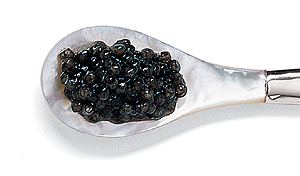
Get it while you can. Beluga caviar from Mackenzie Ltd. |
Bottled Water Bonanza. According to the Beverage Marketing Corporation, bottled water consumption in the U.S. has surpassed that of milk, coffee, and beer. That’s great for the health of Americans, but a challenge to bottled water producers: as the market matures, it will become increasingly important to continue product innovation and to increase brand awareness to combat commoditization and price promotions.
According to a study by international research firm Mintel, half of respondents who drink bottled water prefer spring water to purified water and notice a difference in the taste (interestingly, the two largest American brands, Dasani and Aquafina, are purified tap water). Forty-three percent of respondents feel that there is a significant difference between bottled water brands, and almost two-thirds of respondents are brand loyal. The most discriminating in their views are the segments of younger respondents, Black respondents, and respondents earning under $50,000.
The International Bottled Water Association (IBWA) defines bottled water as water sealed in a sanitary container, to be sold for human consumption. This includes carbonated, non-carbonated and flavored waters.
|
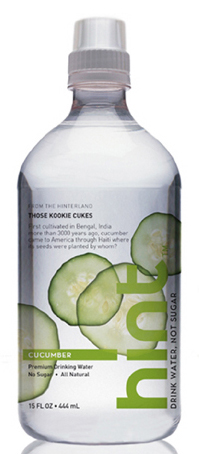
For years spas have been tossing slices of cucumber in water glasses. Now you can buy cucumber infused water from Hint...plus Cranberry-Orange, Lime, Pear, Pomegranate-Tangerine, Raspberry Lime, Tangerine. To get kids to prefer water to sodas and high-sugar juices, there are kid-flavored waters: Apple, Grape, Mixed Berry, Tropical Punch, and Strawberry Kiwi. DrinkHint.com. |
1.2.06
Flavor Forecast. In 2005 it was pomegranate. Prior years brought us international flavors like wasabi and jalapeno. What can we expect in 2006?
Skip Rosskam, President & Chief Operating Officer of David Michael & Company, a developer of flavors for food manufacturers, notes a demand for creates a demand for stronger, more intense flavors(the company recently developed gelato flavors such as apple chervil, blueberry lavender, chocolate espresso chipotle, coconut pineapple thai basil, and pear apricot ginger). He nominates three not flavors to watch for this year and next:
|
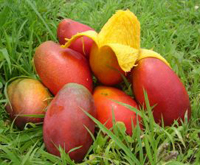
Mango: the next hot food flavor? Photo by Oscar Belen. |
With new year’s resolutions just a few days away, we at THE NIBBLE will do our best to guide people to delicious foods that are healthy too. Click here to see the index page of our Nutri Nibbles section, where you can read our reviews on a nutritious, yet delicious foods; and our Diet Nibbles section, which has many low calorie and sugar-free foods that we think are as tasty as our regular Nibbles.
- Mango. Appealing to Hispanic, Asian, and exotic trends, mango has been available long enough in most supermarkets to be mainstream, even though many people have never tried it. A fruit like guanabana, which is a mango-in-waiting, is too unknown now, but a future hottie.
- Blood Orange. Popular with gourmet chefs and specialty produce suppliers, blood orange is also expanding into the main stream. It looks and tastes wonderful and the name has great appeal. Again, Rosskam stresses that familiarity is important: the name “orange” makes people willing to try it, even though it is an exotic fruit. (Click here to read our review of Original Italian Volcano Blood Orange Juice.)
- Acai. Few people beyond health food followers and Oprah-watchers are familiar with acai (pronounced AH-si-EE), an Amazonian berry. It is higher in antioxidants than blueberries, and tastes blueberries and chocolate! When food producers work out the applications, it may be “the next big thing,”
The Winter Fancy Food Show will be held at the end of this month, and we’ll soon be report back on the early trends in artisanal foods.
Foods Not So Functional. Functional Foods have been quite hot; but now it seems, they may be not (forgive our doggerel).
Functional foods are foods and beverages that serve a helpful effect on the body beyond normal satiation and nutrition. The effect can be long term (“added calcium prevents osteoporosis”) or short-term (“the electrolytes in sports drinks help the body re-hydrate more quickly”). If you look at the label of most functional foods, they doesn't contain enough of the “functional” ingredient to be efficacious—you still need to take calcium supplements, soy, or whatever you are seeking in the functional food. |
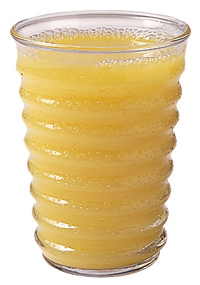 If you’re seeking calcium from calcium-enriched orange juice, check the dosage. The amount you need may need to come from a vitamin supplement. Photo courtesy of 5aday.gov. If you’re seeking calcium from calcium-enriched orange juice, check the dosage. The amount you need may need to come from a vitamin supplement. Photo courtesy of 5aday.gov. |
Trend: More Organics. Most of us will probably be eating more organic foods in 2006. According to Datamonitor, organics continue to grow at roughly 20 percent annually, compared with about 3 percent for the rest of the food industry.
Kenneth A. Gawley, director of marketing for Chr. Hansen, a developer of natural ingredients for food manufacturers and other companies, attributes a key portion of organic growth to greater consumer awareness and desire for better health and healthier foods, while still maintaining the convenience of regular shopping routines. “The average consumer doesn’t necessarily want to have to go to a specialty health food store to get good-for-you, natural or organic-type products if they don’t have to,” he says.
|
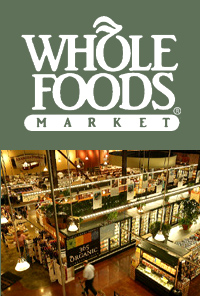
Whole Foods stores have excited many Americans who ordinarily would not have gone out of their way to buy organic products. |
This need, plus an exciting product offering, has accelerated the growth of organic-based food chains like Whole Foods and Wild Oats. Presenting consumers with different brands that often taste better and are better for you, they have brought new perspectives to putting everyday food on the table.The organic industry is regulated by the National Organic Program (NOP) under the U.S. Department of Agriculture. Products marketed as organic must meet one of the NOP standardized labeling criteria, a percentage based on the weight of the organic ingredients:
- “100 percent organic”
- “Organic,” which means it contains 95 percent organically produced ingredients
- “Made with organic ingredients,” which means it must have at least 70 percent organically produced ingredients
Any product with less than 70 percent organic ingredients can identify the organic ingredients in the ingredient statement and information panel.
There is no legal definition of “natural” ingredients. While there is a consensus that a product labeled “natural” should have nothing artificial in it, nothing stops any manufacturer from calling a product “natural.”
While most consumers have relied on the stringent certification process required to label a product organic, and consumer confidence with organics is very high, the certification is not without controversy. Click here to read our recent Organic Matter column on new legislation that will processed foods that contain synthetics to be labeled “organic.” If you want to be absolutely certain your food is organic, learn how to read labels of processed foods.
Cottage Cheese Slump. Perhaps new year’s resolutions to diet will help cottage cheese sales: the segment has been on a downward slide for the past two decades. Apparently, the demographics skew to generations past, and those who are growing old and passing on. The younger generations have been brought up on yogurt, not cottage cheese; and the industry hasn’t done much to appeal to young consumers the way yogurt producers have with kid-friendly packaging, flavors and mix-ins.
|
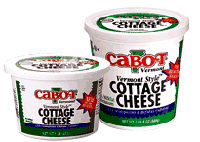
Help save cottage cheese! Introduce your kids to it. |
Send your product news to:
Info(at)TheNibble.com.
Substitute @ for (at)—we use this convention to avoid address-harvesting spiders.
News Archives
| 1st Quarter 2006 |
4th Quarter 2005 |
3rd Quarter 2005 |
|
|
|
| 2nd Quarter 2005 |
1st Quarter 2005 |
|
|
|
|
Lifestyle Direct Direct, Inc. All rights reserved. Images are the copyright of their respective owners. 
|





 Guittard’s new Single Origin Chocolate Tasting Kit comes with four different 10 gram single origin bars and a chocolate tasting guide.
Guittard’s new Single Origin Chocolate Tasting Kit comes with four different 10 gram single origin bars and a chocolate tasting guide. 

 The producers state that the wrappers from Lettuce Jammers are durable enough to hold hot or cold fillings, and that the pieces come in a “boat” shape. But it only takes a few minutes to break off and rinse any lettuce leaves, which come naturally curved to cradle any filling of your choice. It may be the emperor’s new clothes, but if gets more people to substitute lettuce for bread, we’re all for it.
The producers state that the wrappers from Lettuce Jammers are durable enough to hold hot or cold fillings, and that the pieces come in a “boat” shape. But it only takes a few minutes to break off and rinse any lettuce leaves, which come naturally curved to cradle any filling of your choice. It may be the emperor’s new clothes, but if gets more people to substitute lettuce for bread, we’re all for it. 








 If you’re seeking calcium from calcium-enriched orange juice, check the dosage. The amount you need may need to come from a vitamin supplement. Photo courtesy of 5aday.gov.
If you’re seeking calcium from calcium-enriched orange juice, check the dosage. The amount you need may need to come from a vitamin supplement. Photo courtesy of 5aday.gov.
